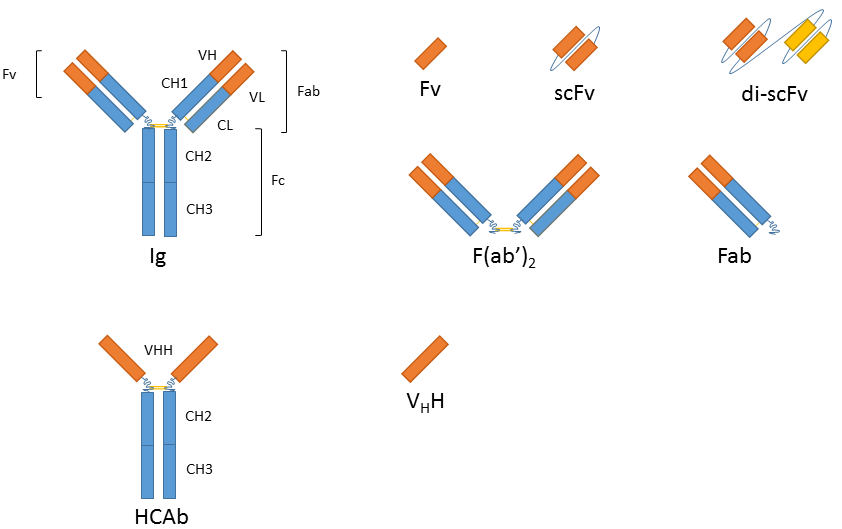NANOBODIES® are tiny, recombinantly produced antigen binding VHH fragments, derived from the Alpaca heavy chain IgG antibody (HCAb).

Pictured Bottom Row: The VHH domain represents the absolute smallest antibody fragment necessary to specifically bind an antigen with exceptionally high affinity.
When compared to traditional monoclonal or polyclonal antibodies, NANOBODIES® are:
- Smaller
- More consistent
- Higher affinity
- Easier to use
NANOBODIES® are available in a variety of formats, antibodies-online offers Catcher for effective pulldown of fusion proteins.
NANOBODIES® have many superior performance characteristics:
| Characteristic | Monoclonal Antibody | Poylclonal Antibody | NANOBODY® |
|---|---|---|---|
| Size | ~150 kDa unconjugated (IgG) | ~150 kDa unconjugated (IgG) | Only ~15 kDa unconjugated |
| Binding Affinity | Medium to High (nM - μM Kd values) | Low to Medium (μM Kd values) | Consistently High (pM - nM Kd values) |
| Lot-to-Lot Consistency | High - Hybridoma cell line production can suffer from "drift" | Very Low - Produced in live animals - significant variance between lots and bleeds | Very High - Recombinantly produced from clonal DNA - same product every time! |
How can I use a NANOBODY® ?
In short, nearly any way you please!
NANOBODIES® come in a variety of formats. They are raised against a fairly diverse range of antigens, and are thus highly versatile tools, capable of being employed in a variety of different situations.
The most common uses for a NANOBODY® are experiments that you are likely already familiar with, like immunoprecipitation, or fluorescence microscopy.
There are also a handful of applications where use of a NANOBODY® is feasible, but use of a conventional antibody would be impractical or impossible.
Custom Antibody Services
Custom Antibody Services
Benefit from combined expertise of antibodies-online and our Partner Rockland Immunochemicals, Inc. Collaborative, experienced, and conducted completely in our own facilities, our custom antibody production services can drive your project from the design and synthesis of your antigen through to production and characterization of your antibody.
Benefit from combined expertise of antibodies-online and our Partner Rockland Immunochemicals, Inc. Collaborative, experienced, and conducted completely in our own facilities, our custom antibody production services can drive your project from the design and synthesis of your antigen through to production and characterization of your antibody.
* NANOBODIES® compounds is a registered trademark of Ablynx N.V.
What is a Nano-Catcher?
Nano-Catcher have been conjugated to agarose or magnetic beads to facilitate cleaner, faster, simpler immunoprecipitations. Nano-Traps are available in a variety of formats, and target a variety of common tags, including Green Fluorescent Protein (GFP), Red Fluorescent protein (RFP), BFP & MBP. Nano-Traps allow you to perform IP experiments with exceptionally high yield, and without contamination from antibody heavy or light chains.
Nano-Catcher significantly improve conventional IP protocols.
- Faster (roughly half the time required for an antibody IP)
- Cleaner (no heavy or light chain antibody contamination)
- More consistent (recombinant reagents for the same interaction every time)
- Higher yield (picomolar to nanomolar affinity constants for GFP and RFP-Catcher)

In order to facilitate the most versatility in IP methodology, all nano-traps come conjugated to agarose beads, ferromagnetic beads, or agarose/magnetic beads.
Nano-Catcher available at antibodies-online:

Offered pre- and post-sales consultation and support to antibodies-online customers. Provided troubleshooting and technical assistance with proteomics and genomics experiments. Composed and distributed cross-channel digital marketing campaigns.
Go to author page



